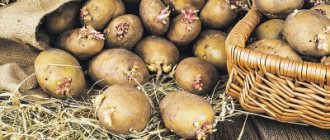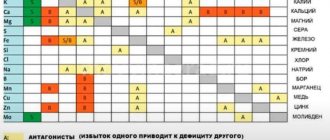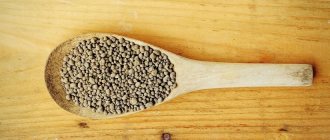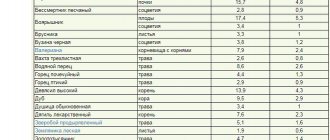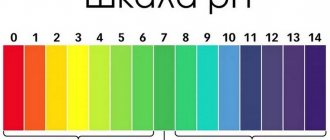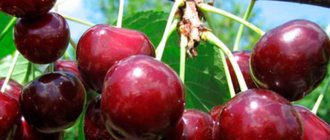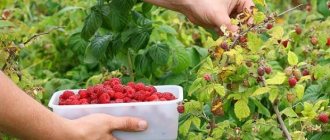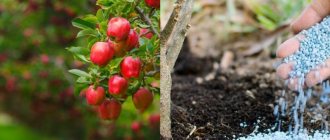Register of measures for determining the weight of fertilizers
To use available measuring instruments, you need to understand how many grams of fertilizer are in a matchbox or other container of different volumes. The result of careful weighing of a specific preparation in familiar household containers was systematized into a reference table of weight measures for various mineral fertilizers.
| Name of fertilizer | Gram in a matchbox | grams in teaspoon | grams in tablespoon | Gram in glass 0.2 l | ||
| Nitrogen-containing | ||||||
| Urea (urea) | 13 | 3 | 10 | 130 | ||
| Ammonium sulfate | 20 | 5 | 14 | 188 | ||
| Ammonium nitrate | 18 | 4 | 12 | 170 | ||
| Phosphorus-containing | ||||||
| Powdered superphosphate | 24 | 6 | 18 | 240 | ||
| Granulated | 22 | 6 | 15 | 220 | ||
| Double | 20 | 5 | 16 | 200 | ||
| Phosphorite flour | 34 | 9 | 26 | 340 | ||
| Potassium-containing | ||||||
| Potassium chloride | 20 | 5 | 14 | 180 | ||
| Potassium sulfate | 26 | 6 | 20 | 260 | ||
| Potassium salt | 22 | 5 | 17 | 220 | ||
| With lime content | ||||||
| Dolomite flour | 30 | 8 | 22 | 300 | ||
| Limestone flour | 34 | 8 | 26 | 340 | ||
| Slaked lime | 12 | 3 | 10 | 120 | ||
| Wood ash | 10 | 2,5 | 8 | 100 | ||
| Peat ash | 8 | 2 | 6 | 80 | ||
| Compound | ||||||
| Nitrophoska | 20 | 5 | 15 | 200 | ||
| Nitroammofoska | 18 | 5 | 14 | 180 | ||
| Potassium magnesium sulfate | 20 | 6 | 17 | 200 | ||
| Others | ||||||
| Copper sulfate | 22 | 5 | 16 | 220 | ||
| inkstone | 22 | 5 | 16 | 220 | ||
| Calcium nitrate | 20 | 5 | 15 | 200 | ||
Formula and composition of superphosphate
Superphosphate has a complex chemical formula (CaH2PO4)2 x H2O + 2CaSO4 x 2H2O .
In fact, superphosphate is not a pure chemical product. The product is produced from apatites, which, in turn, appear due to geological processes.
The fertilizer contains up to 50% phosphorus compounds (monocalcium phosphate and phosphoric acid). In addition, the preparation contains other elements, the proportion of which is much smaller. For example: nitrogen, copper, cobalt, molybdenum, calcium sulfate, sulfur, manganese, boron.
The following varieties of this fertilizer are currently available on the market for agricultural products:
- Monophosphate in the form of a gray powder. Contains only 20% phosphorus. The name “simple superphosphate” is also found. It is used for application to the soil in dry form.
- Double superphosphate contains up to 50% phosphorus. Used mainly in liquid form.
- Granulated superphosphate, in addition to phosphorus, contains calcium sulfate (30%). It stands out for its ease of storage. It is used mainly for feeding cabbage and other cruciferous vegetables.
- Ammoniated superphosphate contains about 30% phosphorus. It is considered a highly effective combined fertilizer because it contains a significant amount of nitrogen.
- Huminized superphosphate is characterized by an increased proportion of magnesium, calcium and humates. It is considered a simple superphosphate.
ON A NOTE. Double superphosphate differs from monophosphate in the production method and the amount of phosphorus in the composition. Monophosphate also contains more sulfur.
How to determine the weight of fertilizer in a 10-liter bucket?
Organic matter or soil mixtures have to be applied in large volumes, so it is not relevant to use a table of the weight of fertilizers in grams. As a measuring container, it is optimal to use a standard-sized bucket, which can be found in the arsenal of any summer resident. Here, the mass of a particular type depends on the condition and density of the additive added, and portions are expressed in kilograms.
| Name of fertilizer | Weight in kg per 10 l bucket |
| Soil | |
| Mature compost | 10 |
| Humus | 8 |
| Leaf soil | 8 |
| Turf | 12 |
| Animal origin | |
| Dry horse manure with bedding | 6 |
| Fresh horse manure | 8 |
| Fresh mullein | 9 |
| Slurry | 12 |
| Chicken droppings | 6 |
| Others | |
| Ash | 5 |
| Dry sawdust | 9 |
| Fluffy | 6,5 |
| Dried peat | 5 |
| river sand | 13 |
Instructions for using superphosphate as a fertilizer in the garden
Typically, superphosphate is used as a root dressing, since phosphorus compounds are poorly absorbed when sprayed. Fertilizer can be applied in dry form, but then it must be buried in the soil so that it does not lose its properties. Dry fertilizing is carried out for long-term nutrition of plants. The water-based solution is designed to quickly saturate the plant with phosphates in case of obvious phosphorus deficiency.
Feeding cucumbers
Cucumbers can be fed with phosphorus-containing fertilizer in several stages.
Fertilizers can be applied for the first time when preparing the soil. It is best to mix the product with other mineral fertilizers to obtain a complex fertilizer. All components (superphosphate, ammonium nitrate and potassium sulfate) are mixed in equal proportions.
When the plant produces the second pair of true leaves, you can prepare the following complex nutrition: dissolve 20 grams of double superphosphate in a bucket of water and add the same amount of potassium sulfate. Water the plants at the rate of 1 liter per 1 bush.
The next feeding is carried out when the first flowers appear. At this moment, increase the concentration of the product (35 g per bucket of hot water). The solution is allowed to cool and left overnight. During this time he insists. The next day, filter and spray.
How to use superphosphate for strawberries in spring
Strawberries respond well to the application of this product. You can use superphosphate alone (10 g per bucket of water), or mixing the drug with mullein and ash. Complex fertilizer is prepared from 1 liter of mullein, 30 grams of superphosphate and 200 grams of ash.
ON A NOTE. If you mix the product with mullein (1 kg) and water (10 l), you will get a fertilizer that can be used to feed the crop after the end of the summer season, that is, in the fall.
Treatment of trees and shrubs with superphosphate
In spring, fertilizer is usually applied during planting (filled into planting holes), or as part of a complex nitrogen-potassium-phosphorus fertilizer.
Autumn fertilizing of fruit and berry plantings helps plants endure winter more easily. For longer-term nutrition, fertilizer is applied throughout the tree trunk to a depth of 10 cm. The consumption rate is determined based on the size of a particular specimen. For 1 medium bush, 2 tablespoons are enough; for an adult apple tree, about 10 tablespoons are needed (or 2 tablespoons per square meter).
IMPORTANT! If you practice regular autumn fertilizing with phosphorus-containing fertilizers, then you periodically need to carry out liming to maintain the acidity level of the soil. Therefore, every 4-5 years add 0.2 - 0.3 kg of lime per 1 square area.
Fertilizing garlic with fertilizer in spring
15-20 grams of product per ten-liter bucket of water.
Superphosphate for onions
15-20 grams of product per ten-liter bucket of water.
How to water SF seedlings
Seedlings require phosphorus compounds for uniform growth and development. Phosphorus-containing fertilizer should be added 2 weeks after picking. Fertilizing is carried out with an extract of superphosphate (how to prepare it is described below).
How to fertilize potatoes
Phosphorus fertilizer can be added when planting potatoes. 1 teaspoon of dry powder per hole is enough. During the growth of the bushes, you can carry out root feeding by dissolving 1 tablespoon of dry matter in 1 bucket.
A few weeks before harvesting, you can spray the potatoes with a light solution of the drug. This will speed up the ripening of the tubers and improve their taste.
How to use superphosphate for cabbage
For cabbage, it is better not to just add a dry granular substance, but to prepare a complex fertilizer from potassium chloride (10 g), ammonium nitrate (15 g) and superphosphate (40 g). Everything is mixed and filled with water. Processing can be carried out both by root and foliar methods.
Raspberry feeding
Raspberries are fed with phosphorus fertilizer during spring planting (40 g of the drug is needed).
The product can be added again at the end of summer. Fertilizer is applied in dry form at the rate of 2 matchboxes of the product per 1 sq. m of raspberry field.
Fertilizing flowers with superphosphate in open ground
Separately, phosphorus fertilizing is carried out at the rate of 30 grams of the drug per bucket of water. In spring, the product is also applied during planting.
Superphosphate for indoor flowers and plants
For house flowers and ornamental plants, phosphorus-containing products are used for general health promotion and prolongation of flowering.
In the first case, you need to mix a complex fertilizer: 1 g of ammonium nitrate, a pinch of potassium salt and a pinch of superphosphate per liter of liquid.
To prolong flowering, you need 3 grams of ammonium nitrate, 6 grams of potassium salt, 6 grams of superphosphate and 5 liters of water.
How to apply for lilies
Garden lilies are fed with phosphorus-containing fertilizer to help the flowers survive the winter and form more inflorescences next year. For a complex effect, superphosphate is mixed with potassium magnesium (2 and 1.5 tablespoons, respectively). Fertilizers are dissolved in water and watered.
Grape feeding
Grapes need to be fed with fertilizer not every year, but approximately once every 3 years. For 1 square meter of soil occupied by grapes you need 2 matchboxes of superphosphate. The drug is buried in the ground by 2 bayonets.
Why do you need to know this?
It is not for nothing that the packages of ready-made nutritional complexes indicate the dose for a particular plant type, taking into account the type of land.
A deficiency or excess of one or another component can negatively affect the size and quality of the crop and subsequently harm human health.
Therefore, if it is not possible to weigh the drug, it is optimal to use a table of fertilizer measures in spoons or other containers.
How much potassium monophosphate is in 1 tablespoon. All about potassium monophosphate
Growing vegetable, berry and flower crops today cannot do without the use of fertilizers. These components not only significantly stimulate plant growth, but also increase their productivity. One such remedy is a drug called monopotassium phosphate. As the name implies, the fertilizer consists of potassium and phosphorus, but if we consider phosphorus combinations of components, then only monophosphate is used in the form of fertilizer. Gardeners and gardeners use this drug as a top dressing, which is applied to the soil, as a result of which the plants receive additional nutrition and develop better.
Peculiarities
Potassium monophosphate has an important feature, which is the versatility of this fertilizer. The product is equally effective for both garden plants and indoor flowers. The use of the chemical monopotassium phosphate not only increases yield, but also promotes resistance to fungal diseases, and also helps to safely survive the harsh winter months.
Fertilizer is intended to be applied to the soil and nourishes the plant by passing through its root system. The composition is applied during picking and planting at a permanent place of seedlings, during the flowering process and after the end of this phase.
The drug is quickly absorbed and actively manifests itself on any type of green space, improving their condition.
In addition to its versatility, potassium monophosphate has other features.
- Under the influence of fertilizer, plants increase their ability to form a large number of lateral shoots. As a result, many flower buds are formed in fruit-bearing species, which eventually form fruit ovaries, increasing productivity.
- Plants absorb this fertilizer well with all their parts. If there is an excess of it, there is no danger of harming the plantings, since the excess fertilizer will simply remain in the soil, making it more fertile.
- Potassium monophosphate can be combined with various drugs designed to combat diseases and pests of green spaces. Therefore, planned treatments and fertilizing can be performed in conjunction with each other.
- If plants have enough potassium and phosphorus during their growth, then they are not susceptible to pests and fungal spores. Therefore, fertilizer is a kind of immune stimulation.
- When potassium and phosphorus are added to the soil, the composition of its microflora improves, while the pH level does not change.
How many grams of spices can a spoon and glass hold?
Of course, the easiest way to measure the quantity and weight of ingredients is with a modern kitchen scale. But what to do when you don’t have a scale or measuring cup at hand, and all the ingredients in the recipe are indicated in grams and milliliters?
In this case, teaspoons, tablespoons and an ordinary (thin-walled, faceted) glass come to the rescue.
How to measure correctly?
For example: the recipe specifies a glass, so we measure with a glass; if it’s a spoon, use a teaspoon or a tablespoon; if the ingredients are indicated in grams, measure with a scale; if in milliliters, then use a measuring cup.
Pour liquid ingredients to the brim of the spoon, viscous ones - to the brim. To determine the correct proportions, you can use the food weights table.
It is important that if 1 teaspoon of sugar is indicated, this means a small heaped spoon of sugar. Other recipes prescribe “1 small spoon of sugar without a slide” - that’s how it should be, without a slide.
| Product name | Small (teaspoon) (gr.) |
| Water | 5 |
| Jam | 5 |
| Coarse table salt | 10 |
| Salt "Extra" | 8 |
| Granulated sugar | 8 |
| Powdered sugar | 10 |
| Wheat or rye flour | 8 |
| Oat groats | 5 |
| Buckwheat (kernel) | 8 |
| Rice, pearl barley | 8 |
| Millet cereal | 8 |
| Wheat flakes | 2 |
| Corn, wheat, barley cereals | 6 |
| Semolina | 7 |
| Hercules | 6 |
| Cornflakes | 2 |
| Cereals | 5 |
| Ground crackers | 6 |
| Sago groats | 6 |
| Beans | 11 |
| Peas | 10 |
| Lentils | 7 |
| Natural honey (liquid) | 10 |
| Poppy | 5 |
| Nuts | 10 |
| Peanuts, shelled | 8 |
| Peeled hazelnuts | 10 |
| Almond (kernel) | 10 |
| Fresh yeast | 15 |
| Dry yeast | 5 |
| Lemon acid | 8 |
| Drinking soda | 12 |
| Gelatin (powder) | 5 |
| Powdered milk | 5 |
| Natural ground coffee | 8 |
| Cocoa | 9 |
| Ground cinnamon | 8 |
| Potato starch | 6 |
| Ground pepper | 6 |
| Egg powder | 6 |
| Vinegar | 6 |
| Liquor | 8 |
| Vegetable oil | 6 |
| Butter and ghee | 6 |
| Melted margarine | 5 |
| Whole milk, kefir, fermented baked milk, sour cream | 6 |
| Condensed milk | 12 |
| Raisin | 7 |
| Dried mushrooms | 4 |
| Cream | 5 |
| Tomato paste | 10 |
The importance of the correct dosage of spices in canning
When canning, hardly anyone can do without the help of a small or large spoon, since if you make an error in the dosage, there is a chance of losing the preparations. To avoid such situations, use the table indicating the number of grams in spoons.
| Product name | Large (tablespoon) spoon (gr.) |
| Water | 18 |
| Jam | 18 |
| Coarse table salt | 30 |
| Salt "Extra" | 25 |
| Powdered sugar | 25 |
| Powdered sugar | 25 |
| Wheat or rye flour | 25 |
| Oat groats | 18 |
| Buckwheat (kernel) | 25 |
| Rice, pearl barley | 25 |
| Millet cereal | 25 |
| Wheat flakes | 9 |
| Corn, wheat, barley cereals | 25 |
| Semolina | 30 |
| Hercules | 12 |
| Cornflakes | 7 |
| Cereals | 14 |
| Ground crackers | 15 |
| Sago groats | 20 |
| Beans | 30 |
| Peas | 25 |
| Lentils | 25 |
| Poppy | 18 |
| Natural honey (liquid) | 30 |
| Nuts | 30 |
| Peanuts, shelled | 25 |
| Peeled hazelnuts | 30 |
| Almond (kernel) | 30 |
| Fresh yeast | 45 |
| Dry yeast | 16 |
| Citric acid | 25 |
| Soda | 29 |
| Gelatin powder | 15 |
| Powdered milk | 20 |
| Condensed milk | 35 |
| Ground pepper | 12 |
| Natural ground coffee | 20 |
| Cocoa powder | 15 |
| Ground cinnamon | 20 |
| Potato starch | 12 |
| Egg powder | 16 |
| Vinegar | 16 |
| Liquor | 20 |
| Vegetable oil | 25 |
| Butter and ghee | 25 |
| Melted margarine | 20 |
| Whole milk, kefir, fermented baked milk, sour cream | 18 |
| Raisin | 25 |
| Dried mushrooms | 10 |
| Cream | 14 |
| Tomato paste | 30 |
Sources used:
- https://superurozhay.ru/podkormka-rastenij/tablica-mer-i-vesov-razlichnyx-udobrenij.html
- https://sovets.net/9207-skolko-gramm-v-chajnoj-lozhke.html
- https://vyrashhivanie-iz-semyan.ru/ogorod/5-gramm-margancovki-kak-otmerit.html

